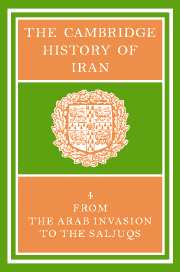Book contents
- Frontmatter
- 1 THE ARAB CONQUEST OF IRAN AND ITS AFTERMATH
- 2 THE ‘ABBĀSID CALIPHATE IN IRAN
- 3 THE ṬĀHIRIDS AND ṢAFFĀRIDS
- 4 The SĀMĀNIDS
- 5 THE EARLY GHAZNAVIDS
- 6 THE MINOR DYNASTIES OF NORTHERN IRAN
- 7 IRAN UNDER THE BŪYIDS
- 8 TRIBES, CITIES AND SOCIAL ORGANIZATION
- 9 THE VISUAL ARTS
- 10 NUMISMATICS
- 11 THE EXACT SCIENCES
- 12 LIFE SCIENCES, ALCHEMY AND MEDICINE
- 13(a) PHILOSOPHY AND COSMOLOGY
- (b) SŪFISM
- 14 THE RELIGIOUS SCIENCES
- 15 SECTS AND HERESIES
- 16 NĀSIR-I KHUSRAU AND IRANIAN ISMĀ‘ĪLĪSM
- 17 ZOROASTRIAN LITERATURE AFTER THE MUSLIM CONQUEST
- 18 ARABIC LITERATURE IN IRAN
- 19 THE RISE OF THE NEW PERSIAN LANGUAGE
- 20 (a) THE “RUBĀ'Ī” IN EARLY PERSIAN LITERATURE
- (b) ‘UMAR KHAYYĀM: ASTRONOMER, MATHEMATICIAN AND POET
- Bibliography
- Index
- Plate section
- Plate section">
- Map 1. Iran under the Abbasids">
- References
10 - NUMISMATICS
Published online by Cambridge University Press: 28 March 2008
- Frontmatter
- 1 THE ARAB CONQUEST OF IRAN AND ITS AFTERMATH
- 2 THE ‘ABBĀSID CALIPHATE IN IRAN
- 3 THE ṬĀHIRIDS AND ṢAFFĀRIDS
- 4 The SĀMĀNIDS
- 5 THE EARLY GHAZNAVIDS
- 6 THE MINOR DYNASTIES OF NORTHERN IRAN
- 7 IRAN UNDER THE BŪYIDS
- 8 TRIBES, CITIES AND SOCIAL ORGANIZATION
- 9 THE VISUAL ARTS
- 10 NUMISMATICS
- 11 THE EXACT SCIENCES
- 12 LIFE SCIENCES, ALCHEMY AND MEDICINE
- 13(a) PHILOSOPHY AND COSMOLOGY
- (b) SŪFISM
- 14 THE RELIGIOUS SCIENCES
- 15 SECTS AND HERESIES
- 16 NĀSIR-I KHUSRAU AND IRANIAN ISMĀ‘ĪLĪSM
- 17 ZOROASTRIAN LITERATURE AFTER THE MUSLIM CONQUEST
- 18 ARABIC LITERATURE IN IRAN
- 19 THE RISE OF THE NEW PERSIAN LANGUAGE
- 20 (a) THE “RUBĀ'Ī” IN EARLY PERSIAN LITERATURE
- (b) ‘UMAR KHAYYĀM: ASTRONOMER, MATHEMATICIAN AND POET
- Bibliography
- Index
- Plate section
- Plate section">
- Map 1. Iran under the Abbasids">
- References
Summary
When the Arabs entered Iran and in 21/642 defeated the Sāsānian army at Nihāvand they brought with them no coinage of their own. In the first years after the conquest of Byzantine and Sāsānian lands the invaders made use of the existing currency - the Byzantine gold solidus or denarius aureus and the copper follies in Palestine and Syria, the Sasanian silver drahm in the east. Within a very few years, certainly by 31/651–2, the Arab governors in Iran began to imitate the drahm, henceforth to be known as the dirham, at first anonymously, later with their names rendered in Pahlavī characters, but always with the addition, in the outer margin of the obverse, of a pious legend in Kūfic characters. The prototypes were the drahms of Yazdgard III, Khusrau II and Hormizd IV; by far the commonest “portrait” is that of Khusrau II whose immense output of coinage during the long years of his reign (591–628) had flooded the land and whose image was familiar to everyone in both Iran and Iraq. An example of Khusrau II's drahm is illustrated in pl. 25(1): on the obverse is the bust of the emperor, with bearded head, right, surmounted by a winged head-dress; at the right in front of the face, his name in Pahlavī; in the margin a Pahlavī legend AFD, of uncertain significance. On the reverse is a fire-altar, flanked by attendants; at the left in Pahlavī, the regnal date 26; at the right in Pahlavī, the mint signature NIH, for Nihāvand.
Keywords
- Type
- Chapter
- Information
- The Cambridge History of Iran , pp. 364 - 377Publisher: Cambridge University PressPrint publication year: 1975
References
- 5
- Cited by

